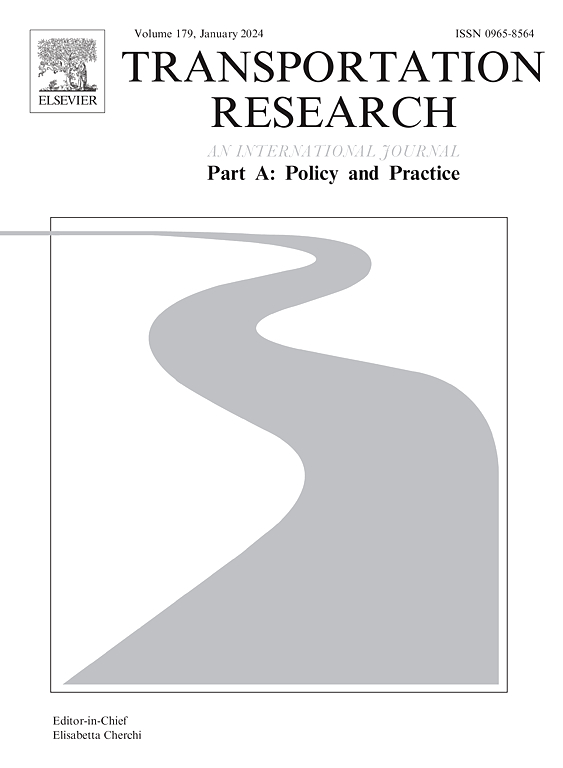骑车人的不同停车偏好及其对自行车停车设施的影响
IF 6.3
1区 工程技术
Q1 ECONOMICS
Transportation Research Part A-Policy and Practice
Pub Date : 2024-11-07
DOI:10.1016/j.tra.2024.104298
引用次数: 0
摘要
在规划自行车停放设施时,了解自行车停放行为至关重要。这对于满足骑车人的需求、有效推广自行车运动以及防止自行车乱停乱放都是十分必要的。因此,本文分析了骑车人对自行车停放设施类型和位置的停放偏好。研究基于一项陈述偏好实验(n = 2,960),针对德国最大的大学之一亚琛工业大学的大学生和员工的自行车停放选择行为。分析采用混合对数模型来估计设施类型和用户特定因素的影响、为停车设施付费的意愿以及自行车绕行和步行距离的相关性。结果表明,骑车人对步行距离的敏感度是绕行距离的两倍多。此外,他们普遍偏好自行车停车站和有顶与无顶停车架,不愿意使用非正规停车设施。虽然以往的研究表明,骑自行车的群体具有不同的偏好和停车行为,但目前还不清楚是哪些因素影响了群体成员的组成。本文表明,学生和就业状况以及自行车的转售价值是影响用户在不同停车设施之间做出选择的重要因素。此外,为自行车停车付费的意愿也很明显,尤其是那些拥有昂贵自行车的人。自行车骑行者在偏好上的巨大差异强调了在规划停车设施时考虑自行车骑行者的异质性以优化其效用的重要性。本文章由计算机程序翻译,如有差异,请以英文原文为准。
Cyclists’ heterogeneous parking preferences and their implications for bicycle parking facilities
Understanding bicycle parking behavior is essential when planning bicycle parking facilities. This is necessary in order to meet the needs of cyclists, to effectively promote cycling, and to prevent fly parking of bicycles. Therefore, this paper analyzes cyclists’ parking preferences regarding the type and placement of bicycle parking facilities. The study is based on a stated preference experiment (n = 2,960) on the bicycle parking choice behavior of university students and employees of RWTH Aachen University, one of the largest universities in Germany. The analysis employs a mixed logit model to estimate the influence of facility type and user-specific factors, the willingness to pay for parking facilities, and the relevance of cycling detours and walking distances. The results indicate that cyclists are more than twice as sensitive to walking distances than to cycling detours. Furthermore, they have a general preference for bicycle parking stations and covered versus uncovered parking racks, as well as a reluctance to use informal parking facilities. While previous research has shown that groups of cyclists have different preferences and parking behaviors, it has been unclear what factors influence group membership. This paper shows that student and employment status and the resale value of the bicycle are important user-specific factors influencing the choice between parking facilities. Furthermore, there is a notable willingness to pay for bicycle parking, especially among those with expensive bicycles. The considerable variation in preferences among cyclists underscores the importance of considering the heterogeneity of cyclists when planning parking facilities to optimize their utility.
求助全文
通过发布文献求助,成功后即可免费获取论文全文。
去求助
来源期刊
CiteScore
13.20
自引率
7.80%
发文量
257
审稿时长
9.8 months
期刊介绍:
Transportation Research: Part A contains papers of general interest in all passenger and freight transportation modes: policy analysis, formulation and evaluation; planning; interaction with the political, socioeconomic and physical environment; design, management and evaluation of transportation systems. Topics are approached from any discipline or perspective: economics, engineering, sociology, psychology, etc. Case studies, survey and expository papers are included, as are articles which contribute to unification of the field, or to an understanding of the comparative aspects of different systems. Papers which assess the scope for technological innovation within a social or political framework are also published. The journal is international, and places equal emphasis on the problems of industrialized and non-industrialized regions.
Part A''s aims and scope are complementary to Transportation Research Part B: Methodological, Part C: Emerging Technologies and Part D: Transport and Environment. Part E: Logistics and Transportation Review. Part F: Traffic Psychology and Behaviour. The complete set forms the most cohesive and comprehensive reference of current research in transportation science.

 求助内容:
求助内容: 应助结果提醒方式:
应助结果提醒方式:


